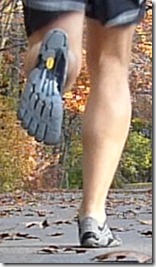 After posting videos of my running form in several shoes on Thursday, I was curious to see what things looked like in a few other options, particularly some zero drop shoes and a shoe with a higher drop.
After posting videos of my running form in several shoes on Thursday, I was curious to see what things looked like in a few other options, particularly some zero drop shoes and a shoe with a higher drop.
Yesterday I took my camera out to the street in front of my house and shot posterior-view video of me running in the Vibram SeeYa LS, Merrell Flux Glove Sport, Altra Instinct 1.5, and Saucony Ride 5. My sense is that I was midfoot-forefoot in the first three, mild heel in the Ride 5, which matches how I feel when I run in the shoes on the road. It was an overcast day and the zoom isn’t quite as good as in my previous videos, but you can still see things pretty well.
As always, feel free to leave a comment!
Below is a compilation video of me running in 7 different footwear conditions:
To view more slow-motion runng videos, visit the Runblogger YouTube Channel.
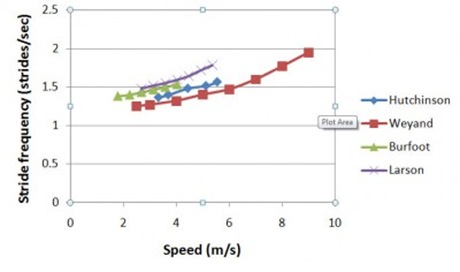
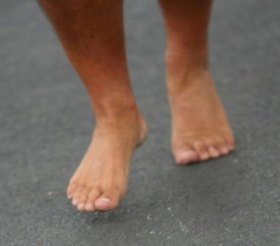
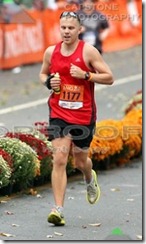
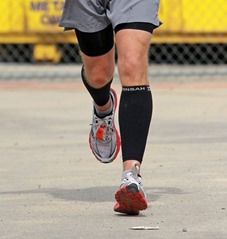














After watching all the videos, I thought you looked the most natural in the Vibrams. I didnt like the way your foot/ankle came down in the Altra’s at all. Merrills were the second choice as it seems more like the VFF’s. I never really thought that much about it, but seeing you run from behind shows the stress the ankle goes through. Just reconfirmed that good form goes a looooong way in injury prevention! Thanks for taking the time to do these videos. :)
I’d be interested to hear how you personally ‘rate’ all of the shoes you’ve just filmed yourself in… In other words, does your body’s feedback in terms of a “I like these” mirror any particular trend in the video?
I’d say my form feels best in the Merrells, Vibrams, and Skechers among the shoes show here. Altras not bad, but a bit of a stiff sole and what looks like some medial compression under the forefoot.
—-
Pete Larson’s Web Links:
My book: Tread Lightly – link to ow.ly
Blog: https://runblogger.com
Twitter: link to twitter.com
Facebook: link to facebook.com…
I’ve never tried any of the Altras personally because I don’t think they’re available in Canada. However, the Instincts in particular seem quite heavy with a fair bit of cushioning and a pretty high overall stack height. My understanding is that the cushioning is on the firmer side, but it seems like the only things that are “minimalist” about these shoes are the wide toe box and the zero heel-to-toe offset.
Pete, there were some comments in the previous post about your “crossover gait”, but it does not seem as noticeable in these videos. And it seems that it’s mainly the left leg that crosses over. Was that something that you were consciously trying to change in these videos? I’m asking because I am also an “overpronator” who crosses over and it’s something that I’ve been working on by mainly trying to engage by glutes and hip rotators and abductors more.
I’d dd though that although I feel good in the most minimal shoes, I think they fatigue me faster and are harder on the calves. Could proabably adapt with time if I went exclusive.
—-
Pete Larson’s Web Links:
My book: Tread Lightly – link to ow.ly
Blog: https://runblogger.com
Twitter: link to twitter.com
Facebook: link to facebook.com…
Oh my gosh, I love this. You are my new favorite blog. I’ve landed here often linked from other sites but now I come here and spend tons of time. Been in an 8 month minimal transition. From Nimbus to Scott Race Rockers to Kinvaras to VFF Speed. All knee pain went away. Your comparison to the Rides is interesting. I was looking for something a little more supportive than the Kinvaras after a ten mile race, prepping for a spring marathon and jumped on the Rides. All kinds of knee pain. Not sure what’s going on. But the video helps, maybe I’m not running as mid foot as I can in my Kinvaras. Again, love those videos, thanks for doing it!
I think the form looks best in the five fingers. I did not see the same “jolt” to your ankle that I see with all the shoe combinations as your foot rolled in at each stride.
you looked better with the vibrams
Seems to be the common response!
—-
Pete Larson’s Web Links:
My book: Tread Lightly – link to ow.ly
Blog: https://runblogger.com
Twitter: link to twitter.com
Facebook: link to facebook.com…
I thought you looked best in the Vibrams – even better than when barefoot. The lower you get to the ground, the more efficient your stride looked – smoother, quicker through the feet. Also, less crossover on the gait.
I wonder if the extra protection to the soles accounts for the “quicker” through the feet look in the Vibrams. I do very little pure barefooting because of gravel and goat heads. When I do barefoot, I tend to be slower overall and through my feet. I got a pair of Feelmax Osmas about three years ago (selection for minimalist shoes has exploded since then) and found that ground contact time was much shorter with those rather than bare skin on pavement.
Good question on contact time – I have video that would allow me to address that from the NYC Barefoot run, just need to analyze it!
Hi Pete,
Just several comments. I know from following all your posts that you are a well educated and smart guy, so I am sure you will agree with the following:
1) I am a little disappointed that your only reference to your running style is when you say “I am mid-forefoot in some, and mid-rear foot in others, for two reasons. First, because it frustrates me in the minimalist/barefoot domain that everyone JUST focuses on foot strike, like its somehow the sole representative of what these shoes are doing or how your running style is classified. “oh I used to heel strike but now I moved to VFF’s I only forefoot strike” is what we hear a lot. Running is comprised of a huge amount of movements, displacements rotations, flexions etc that all have some role in both impact attenuation and injury risk, and in fact we still dont know IF any footstrike is better than others – just look at how much elite athletes vary (my point here – we are all different).
And also actually because I dont think in any case you are remotely close to forefoot striking, but thats just a minor point.
2) yes your form changes in each clip, but does this really matter? over longer runs and with some volume do you have any problems? do you get specific niggles or injuries? It seems to me that you wear a huge amount of different shoes, and don’t report many injuries on your blog, which actually means “who cares” about how your running form changes if it works for you in each case. (this point can be debated from a performance perspective, but another time). Again, it comes back to the fact that there is no perfect gait – for ANYONE, so we need to find something that works and run with it.
3) it is very difficult to decide IF and WHAT form is better for you when you are jogging 100m in the clip, because generally we see that runners change or optimise their running style to something consistent somewhere around 2-6 minutes into a run (or faster for elite), since you also said that you fatigue a lot in the VFF’s, even though everyone is saying here that you look a little better in this condition, this may not be the case 2 miles down the road.
Just some points to debate, keep up the good work.
John,
You’re preaching to the choir here, in fact my entire book hammers on the points that you have made. Regarding your points:
1. I mentioned only the foot strike specifically for the exact reason you mention – because that’s what everybody focuses on and I didn’t want that to be the sole thing mentioned in comments, which is what would have happened had I not made the point myself. I left the rest out because I wanted people to look, observe, and comment without my bias – this is intended to be fun and educational, not a detailed form analysis. Regarding forefoot strike, I know that I am doing so in some instances (barefoot, Vibrams) because I have lateral views as well, but they didn’t come out as well because of motion blur so I didn’t post them. I’ve videotaped myself often enough in many of these conditions to know how I run in the various shoes. It’s also very difficult to assess foot strike in posterior view, very easy in sagittal plane video. I’ve analyzed literally well over a thousand videos for foot strike, and have published on it in academic journals, so it’s something I’m very comfortable doing.
2. The whole point was to show that my form changes a bit with each soe. For me it doesn’t matter much because I’m lucky to be pretty adaptable, but for another person it could matter a lot, and considering the effects of footwear is critical since they can affect people in different ways.
3. There is no ideal way to film runners. The two methods most typically used in scientific studies are exactly what I did hear, or via using a treadmill. Neither of these will perfectly emulate what a runner is doing outside on the road after 20, 40, 60 minutes of running. But, they can give you and idea of specific issues, so there is value. For example, I can very clearly see my left-right asymmetry in the videos, which I’ve known about for a long time, and you can get a good idea of how shoes differ. I’ve published a study looking at form change from mile 6 to mile 20 in a marathon (link to ncbi.nlm.nih.gov…, so I’m well aware that things change, but you won’t be able to do that type of comparison if you are a therapist or working in a shoe store, so you work with what you can get.
Pete
—-
Pete Larson’s Web Links:
My book: Tread Lightly – link to ow.ly
Blog: https://runblogger.com
Twitter: link to twitter.com
Facebook: link to facebook.com…
Definitely prettiest in Five Fingers. Just seems smoother. Your legs sort of snap in to place in the other shoes. Can’t say if it’s universally better, but it looks better IMO. Interesting comparison.